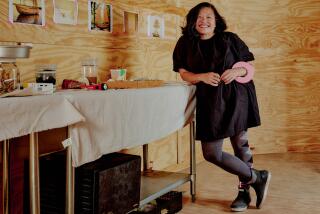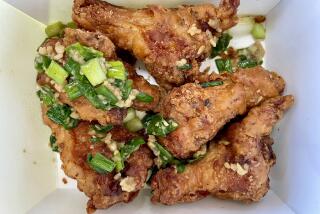Banh cuon 101: Everything you need to know about Vietnamese rice sheets
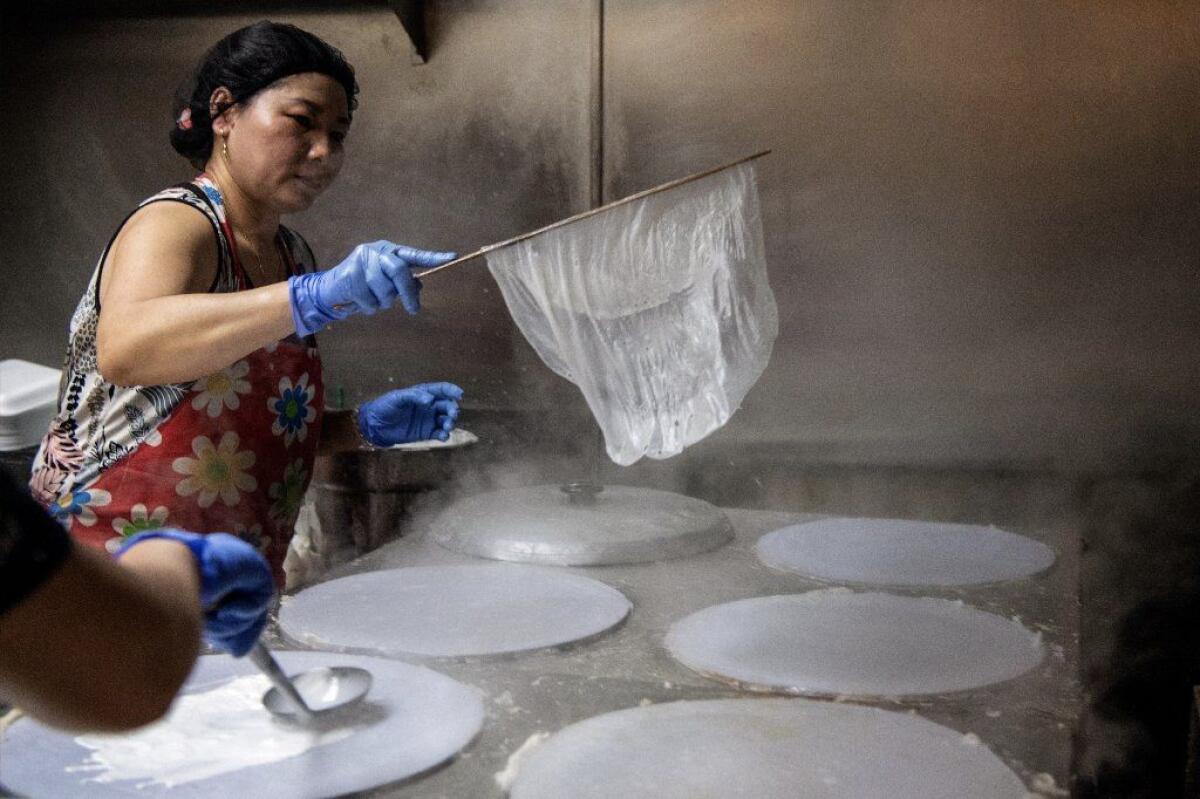
- Share via
I grew up scarfing platefuls of banh cuon — rice noodle rolls — which my parents fashioned from freshly made rice sheets that they’d line with a pork, shrimp and mushroom mixture and then fold into tender cylinders (imagine savory rice-based blintzes). They were one of my favorite things to eat for breakfast.
Though banh cuon (say “baan? quoon?”) literally means rolled cakes, the term refers to the steamed rice sheets themselves, which may be served as is, laid out flat with toppings such as fried shallot and fresh herbs, or they may be filled and rolled. There are endless garnishes and sides to fancy things up, but regardless of presentation, banh cuon is typically enjoyed with a drizzle of or dunk into nuoc cham, the ubiquitous Viet tangy dipping sauce.
Lucas goes to Orange County with chef Shawn Pham for some of the best Vietnamese food you can find outside of the country itself.
For the record:
11:10 p.m. June 20, 2019An earlier version of this story said Luoc Thi Vu and her sister are the co-owners of Banh Cuon Luu Luyen in Garden Grove. She passed the business to her children, Delena and Garden Ta, who are the shop’s co-owners.
The sheets are traditionally crafted from velvety rice batter that’s spread out onto fabric stretched over a pot of simmering water; when just done, a long, slender stick is slid under the rice sheet to lift it off the fabric. In Vietnam, there are legions of banh cuon cooks (most are women) who practice their craft in storefronts, alleyways and sidewalks. Many begin serving in the very early morning to provide cheap, fast breakfasts to regular customers.
Compared with Chinese cheong fun, the dim sum stalwart, banh cuon are more delicate in texture (you can easily cut them with chopsticks as you eat, no scissors needed), lighter in flavor and great at room temperature or slightly warm.
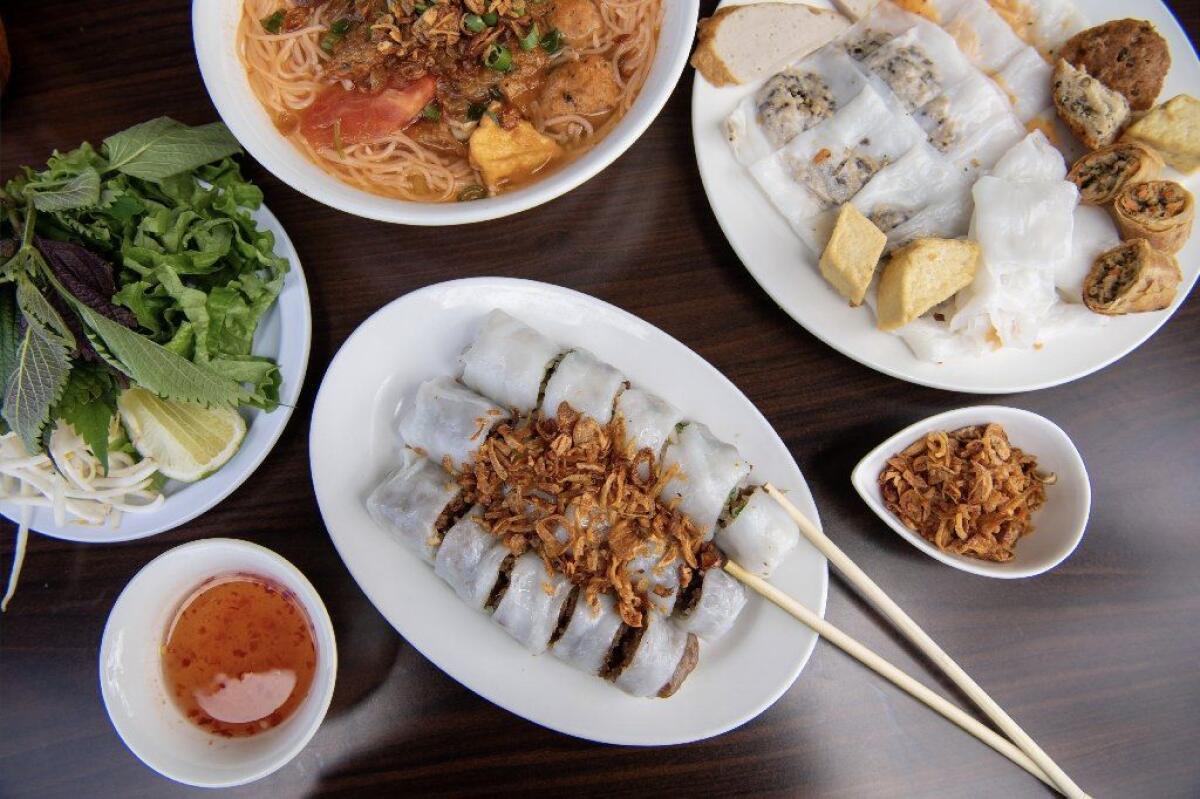
Here in America where banh cuon isn’t readily available on the street, Viet-expats like my mom have long resorted to a simplified version made in nonstick skillets. The results are very good but, because of the cooking method, they’re never as lithe and elegant as banh cuon made with steam heat. To have an ethereal banh cuon experience, you go out for it.
Luckily, there are wonderful opportunities in Orange County’s Little Saigon. Some Viet restaurant menus include banh cuon, but you may have overlooked them because of awkward descriptions such as “flour sheets” or “rice roll cake.”
Ordering banh cuon can initially seem confusing, but like iconic Viet foods such as banh mi, the thing to keep in mind is you can have it your way. Choose plain rice sheets (banh cuon Thanh Tri) to savor the purest expression of rice and gauge the cook’s craft (silky thin ones that are tender-springy are ideal). Or, go for filled ones such as banh cuon tom or banh cuon nhan thit, which respectively signal a filling of ground shrimp or pork, woodear mushroom and onion. Standard garnishes include hanh phi, fried shallot and rau tron, a salad-ish mixture of blanched bean sprouts, cucumber and chopped cilantro and/or mint.
After settling on a banh cuon style, consider extras to add textural and flavor contrasts plus fun. The usual options include: Viet-style sausage (unfried gio lua or fried cha chien), fried tofu (dau hu chien), crunchy fritters featuring mung beans (banh cong) and/or shrimp (banh tom), crisp pieces of cha gio imperial rolls and grilled pork (thit nuong). When you can’t decide or just want to try everything, go for banh cuon dac biet (a.k.a. banh cuon thap cam), the sampler plate.
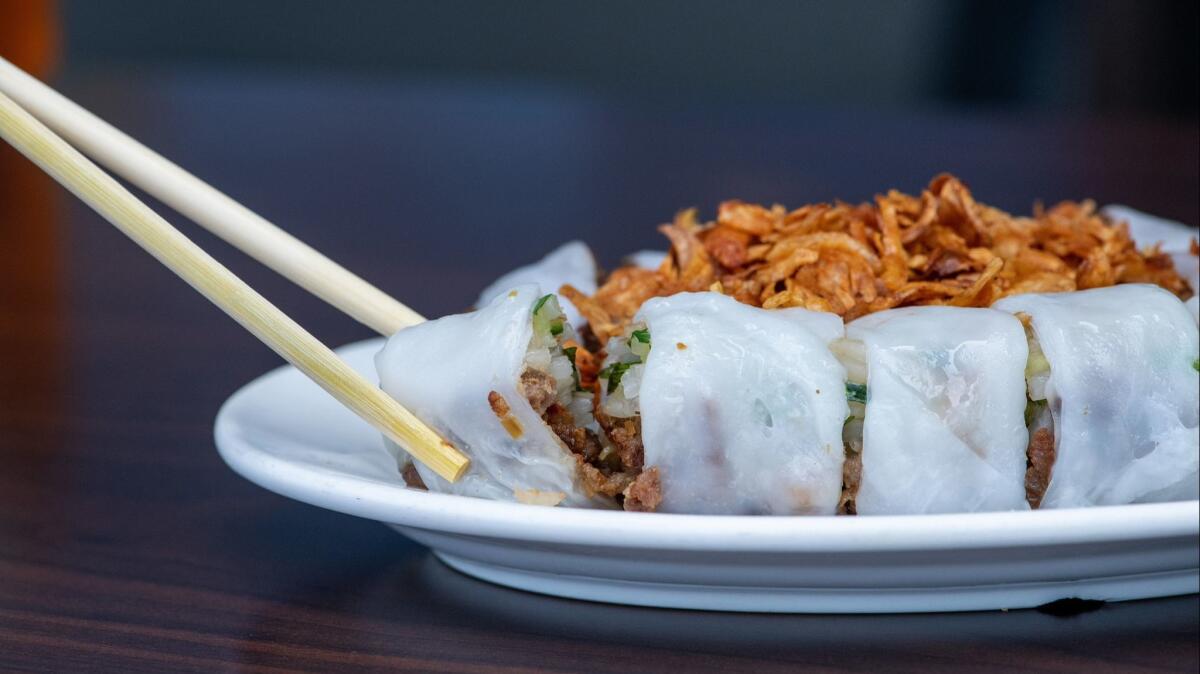
Sometimes banh cuon hides on a menu. For example, at Quan Hy, a central Vietnamese spot, look for banh uot thit nuong, which are rice sheets made in a slightly thicker style to contain grilled lemongrass beef and herbs; enjoy the hearty rolls with the restaurant’s savory-sweet fermented bean sauce.
Once you’re hooked, visit a specialty food shop such as Lo Banh Cuon Tan Hoang Huong. It’s a takeout joint so peruse the grab-and-go options for a quick snack or lunch. Or, buy banh cuon by the pound; whether you choose plain rice sheets or filled ones, your purchase includes fried shallot, bean sprouts and sauce so you have a simple ready-to-eat kit. A pound will easily satisfy two people. Pick up some other snacks to build a great takeaway meal.
For the ultimate experience, head to Banh Cuon Luu Luyen, located, like so many of Southern California’s restaurant gems, in a low-key strip mall. Inside the small restaurant toward the back, you can get a close-up view of how the rice sheets are made.
On a recent visit, while watching the ladies doing their balletic, precise work, I realized that mastering banh cuon is a form of what Viet people call cong phu (think Chinese kung fu), an art or skill that involves hard work, patience and practice. Finessing the batter and consistently yielding stellar results is difficult, I said to Luoc Thi Vu, who passed the business to her children, Delena and Garden Ta, the shop’s co-owners.

They conjures up the batter from rice flour, tapioca starch, potato starch and wheat flour. It’s a multiday process, she said. On weekdays, they make about 200 pounds of rice sheets. On weekends, their production doubles.
An artisanal product, each rice sheet weighs a few ounces, yet plain banh cuon Thanh Tri sell for $3.50 per pound, a dac biet plate goes for $7.99 and an order of three plump rolls containing lemongrass grilled pork is $7.75. “Your prices are too low,” I said to her, adding that people needed to better appreciate the craftsmanship that goes into foods such as banh cuon.
I noted that Vu, a gentle woman who wore a rosary around her neck, was content with where she was. But after a short while, the corners of her mouth lifted upward into a slight smile as she conceded, “You know, it does take a lot of labor.”
Where to satisfy your banh cuon cravings
Banh Cuon Luu Luyen, 14351 Euclid St., Ste. 1J, Garden Grove. Cash only.
Lo Banh Cuon Tan Hoang Huong, takeout only, 5015 W. Edinger Ave., Ste. H, Santa Ana
Quan Hy, 9727 Bolsa Ave., Westminster
Pho Tau Bay LTT, 3610 W 1st St, Ste C, Santa Ana. Cash only.
Bonus banh cuon tips
Named after a village on the outskirts of Hanoi, banh cuon Thanh Tri are the best bet for takeaway. The plain, unfilled rice sheets keep well for five days in the fridge and refresh easily. (Stuffed ones can stiffen too much.) Let the rice sheets sit for about 15 minutes to take off some of the chill, then peel them apart and cut or tear into large pieces, setting them on a plate; it’s OK if there are three to five layers. Microwave using 20- to 30-second blasts until just barely warm, then add toppings and serve with sauce and any side.
When a restaurant has a beer mug (or similar vessel) of nuoc cham on each table, it’s meant for easy self-service. Use the accompanying ladle to put some in a small bowl and add chile sauce, if you like. Then dunk or drizzle onto banh cuon before eating.
Regional banh cuon preferences go like this: Conservative Hanoi-style aficionados add shallot and herbs but shun the sprouts and cucumber, saying they distracts too much. Freewheeling Saigon-style banh cuon lovers load up with all the fixings.
More to Read
Eat your way across L.A.
Get our weekly Tasting Notes newsletter for reviews, news and more.
You may occasionally receive promotional content from the Los Angeles Times.

